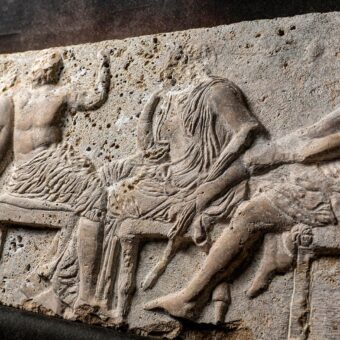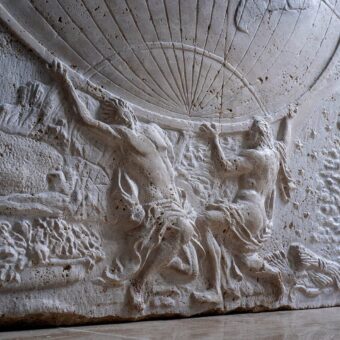HERM
PARTIAL REPLICA OF «ERMA CON BARBATA DI HERMES» (2nd century AD)
PALAZZO MASSIMO ALLE TERME MUSEUM (ROME)
FINDING PROTECTION IN THE SOLITUDE OF THE ROADS OR GOING THROUGH CROSSROADS WRAPPED IN NEGATIVE LEGENDS, COULD BE REASONS FOR THE BIRTH OF THE FIRST ARCHAIC FORMS: STRETCHED STONES (BETILOS) IN THE PILGRIMS AND EATEN IN THE PILGRIMS AND LANDS OF THE FOREGRINES.
| Weight | 40 kg |
|---|---|
| DIMENSIONS | 62 CM Ø, 6 CM (D) |
| MATERIAL | TRAVERTINE CRON |
| DELIVERY TIMES: | 35- 45 DAYS |
Finding protection in the solitude of the roads or crossing crossroads wrapped in negative legends could be reasons for the birth of the first archaic forms: standing stones (betyls) in which pilgrims and merchants found shelter and strength. These “amulets”, which could evoke Mother Nature or the presence of a divinity, acquired a sacred character together with their location. In gratitude, stones were piled up at the foot of the milestones, garlands of flowers were hung or dried figs were placed to quench the appetite of the needy traveler.
It was the ancient Greeks of Attica, who consecrated these pillars to the god Hermes for representing the spirit of passage and journey (from whom it would take its name). The messenger of Olympus was a multifaceted god who guided souls to the underworld, protected shepherds, guarded borders, and was cunning in commerce. What were originally simple blocks of stone are now crowned with a bust representing Hermes, the first attempt at artistic development.
With their apotropaic function resolved, they were placed at highway border points and at the limits of roads and properties to later also fulfill informational functions: distances relative to the route were indicated on the front and sentences of a moralizing nature could be read. In addition, many had an erect phallus that symbolized fertility.
Was the herma for the Romans an alien object? Not much less, but they would transform it like so many other things. Produced on Italian soil or imported, they appear in territories outside of Greece. What until now was its frequent location (roads, funerary context or in the urban furniture of the polis) reaches the private sphere, divided into peristyle and domus. In turn, they elect new divinities and illustrious personages who bear honorary inscriptions. Ultimately, they will go from being objects of worship to become merely ornamental objects. And in this last line they could simply play: colored marbles, use of bronze, search for the archaic style, double hermas, forming part of fences and balustrades… these are just some of the changes that are brewing with their evolution.
In choosing this piece we kept all of the above in mind. Their right position in accessing a home can fill the space with symbolic charge (protection, renovation, transformation…). Dazzled by the archaic style to look for an iota of tenderness in it, we imagine it paired, attached or in its eternal isolation. And in our interpretation we wanted to connect with the origin of the herma through roots, a delicate work in forging, which runs through the stipe to recall its roots in the earth, to mother nature and to give thanks as an offering.



















